WHAT'S NEW:
Eruption Confirmed!
New lava (rumbleometer stuck in flow) SE rift zone
(posted 9/1/98)
BACKGROUND:
Technology (ROV, ships, etc.)
Other 1998 Axial cruise reports
EXPEDITION:
Science Objectives
Calendar
Today's Science News
Participant Perspective
Teacher Logbook
EDUCATION:
Curriculum
Teacher Observations
Questions/Answers from sea
MULTIMEDIA:
(video clips, animations, sounds)
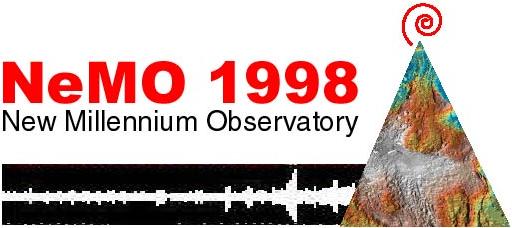
Logbook
September 12, 1998
September 12, 1998
Contents:
Science Report
CHIEF SCIENTISTS WEEKLY REPORT
This week has gone by very fast, and, in the view of the NeMO98 science party,
has been a watershed in terms of scientific return with a remote vehicle. The
ability to interactively explore and sample the site of a recent deep-sea
eruption over several weeks is presenting new opportunities on a dive by dive
basis. All of us realize that the window of opportunity is limited and that we
have to make as much as we can out of each trip to the seafloor. The system
will no doubt undergo considerable change before the NeMO 99 expedition, and
every effort is being made to deploy all the monitoring instruments and to take
as many key samples as is possible.
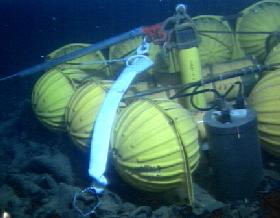
The dive last night capped off another exciting week. We began with the successful implementation of the first stage of a plan to recover the Rumbleometer that is now stuck in the lava flow. The ROPOS team carried a line and weight to the seafloor near the instrument and attached the line to the top of the instrument (see photo right). On a future dive, an attempt will be made to pull the instrument free of the seafloor with a line between the ROPOS "cage" and the instrument. Careful observations in the vicinity of the Rumbleometer suggests that the lava is about 6 to 8 feet thick so it's somewhat of a mystery why the instrument wasn't completely buried! ROPOS also transited over the site of the current meter mooring that never returned after being called back on Leg I of NeMO98. This site was also covered with new lava, and it's now pretty certain that the mooring was damaged and/or released by the lava flow.
A remnant from a visit to Axial caldera in 1996 or 1997 also provided a "smoking
rope" to the lava story. As was described here in reports from the first part
of the expedition, the position of ROPOS on the seafloor is tracked with the aid
of undersea sonar "beacons" called "Transponders". After the transponders we
used here in both 1996 and 1997 were released (and recovered on the surface),
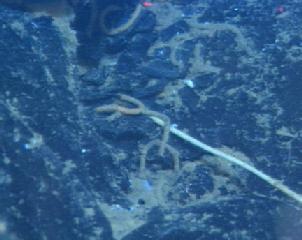 the thin nylon line linking the floating transponder to the weight on the
seafloor fell back to the seafloor. After locating this line draped on older
lava (we knew its position from a dive with ALVIN in July), it was followed back
to the contact where a close-up photo (photo left) clearly shows it
disappearing beneath the lava! It doesn't get much better than that!
the thin nylon line linking the floating transponder to the weight on the
seafloor fell back to the seafloor. After locating this line draped on older
lava (we knew its position from a dive with ALVIN in July), it was followed back
to the contact where a close-up photo (photo left) clearly shows it
disappearing beneath the lava! It doesn't get much better than that!
One of the most interesting characteristics of the new lava is a nearly
ubiquitous coating of what appears to be a brown to tan fluffy "mat" on its
surface. Without close examination, this coating (photo below right) makes the
lavas appear much older, so there was some initial confusion about distribution
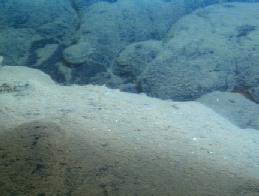 of new lavas. The primary goals of last night's dive were to map the
distribution of the new lava, and to collect samples of the basalt and the
various types of material coating its surface. On one of our tracks, we also
happened across a site that the biologists have been hoping to find since the
beginning of the dives. Growing around small holes in the lava where warm vent
fluid was emerging were pockets of tiny tubeworms, (photo below left)
representing the first stage in the recruitment of these ubiquitous vent fauna.
The sample taken at that site will probably be one of the most important
biological samples taken during NeMO98.
of new lavas. The primary goals of last night's dive were to map the
distribution of the new lava, and to collect samples of the basalt and the
various types of material coating its surface. On one of our tracks, we also
happened across a site that the biologists have been hoping to find since the
beginning of the dives. Growing around small holes in the lava where warm vent
fluid was emerging were pockets of tiny tubeworms, (photo below left)
representing the first stage in the recruitment of these ubiquitous vent fauna.
The sample taken at that site will probably be one of the most important
biological samples taken during NeMO98.
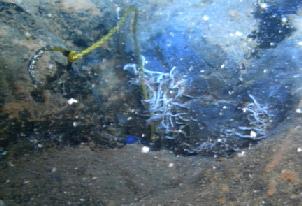
One of the most important developments during the past week was the success of the Vent Fluid Sampler. The success of this system over two long dives has provided much need samples for the NeMO98 chemistry and microbiology programs.
We also successfully recovered the "Extensometers" on the north rift and are now in a position to re-deploy them for another year on a later dive. Four of the instruments recorded data over more than a year and we are looking forward to seeing any sign of seafloor "stretching" during the 1998 event.
The dives at the ASHES vent field were very successful and provided our first
intensive look at this site on the opposite side of the caldera from the
eruption area. In contrast to the east side of the caldera, this site is
characterized by intense high-temperature venting (up to about 345 deg C!). The
ASHES vents are fed by fluid that has probably been in contact with the magma
source that probably lies about 1 mile beneath the caldera. The "fault" nearby
provides a zone of crushed rock wherein hot fluids can rise very fast without
mixing with cold seawater and exit the seafloor retaining their high
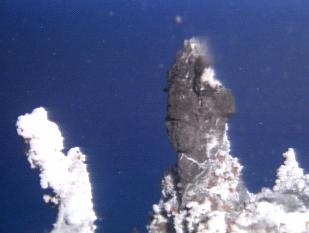 temperature. The unique characteristic of ASHES is that it resides at a depth
where boiling occurs well within the range of hydrothermal fluids. Gas breaks
out of the fluid at about 348 deg C and very gassy fluids have been recovered
from this site as long ago as 1986. However, the bubbling vents seen by the
ROPOS video (photo right) were an unexpected surprise. The jury is
still out on how much ASHES was affected by the 1998 eruption and earthquakes.
temperature. The unique characteristic of ASHES is that it resides at a depth
where boiling occurs well within the range of hydrothermal fluids. Gas breaks
out of the fluid at about 348 deg C and very gassy fluids have been recovered
from this site as long ago as 1986. However, the bubbling vents seen by the
ROPOS video (photo right) were an unexpected surprise. The jury is
still out on how much ASHES was affected by the 1998 eruption and earthquakes.
Only one more week in this expedition and much is yet to be accomplished. In particular we have a full schedule of deployments for our year-long monitoring systems and recoveries for experiments placed earlier during this expedition. Measurements made with a time-lapse camera, a chemical sampling system (Osmosampler), and numerous temperature probes will be our only link between the NeMO98 and the NeMO99 expeditions. (Stay tuned in 1999!)
The ROPOS is almost ready to go back in the water. Goodbye for now.
Bob Embley Chief Scientist of the NeMO98 Expedition
Listing of all Science News postings
Life at Sea: Participant Perspective
Julie Huber
Graduate Student,
University of Washington
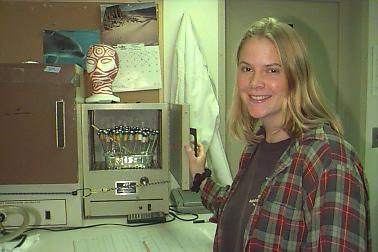
As a first year graduate student at the University of Washington, this expedition aboard the RH Brown is all new to me! I just moved to Seattle a couple of months ago from Florida, so the great Northwest is a big change for me, especially since my previous research took place in the clear warm waters of the Bahamas. Believe me, doing research from a 15 foot Boston Whaler where you can hop out any time to take a swim is a lot different from oceanographic research in the mighty Pacific over an active volcano! So far, though, I have no complaints and am overwhelmed with the abilities of the scientists, crew, and ROPOS technicians aboard. Exploring the bottom of the sea is no easy task, and I am constantly impressed with what we manage to accomplish. I do miss being able to walk in a straight line for more than 50 feet without running into a staircase, crane, or even the ocean, but I'm willing to make some sacrifices for this great opportunity.
Along with Jon Kaye, I am studying the microbiology of the hydrothermal vent systems at Axial. Although the vent environment is a grueling one, with high temperatures, pressures, and concentrations of metals and gases, microbes thrive in places like this. I am looking at the microbial community in diffuse flow sites. While you may have heard a lot about the giant smokers, not much is known about diffuse flow, which is much cooler than smoker chimneys, ranging in temperature from 3-50 degrees C. Where there are cracks in the basalt sea floor due to hydrothermal activity, we usually find diffuse flow. I am trying to figure out the basics, like what kinds of microbes live in diffuse flow? Where are they coming from- the subsurface seafloor or simply from surrounding seawater? How does the community composition change over time, especially related to the chemistry of the flow? By nature, oceanography is an interdisciplinary science, so I am trying to incorporate chemistry and geology with my biological research. Besides culturing microbes in the laboratory under various conditions, I'll also be using some molecular biology to examine the microbial population of the diffuse flow community. This method involves collecting environmental DNA from a sample, vent fluid in this case, and concentrating the microbes from that sample onto a filter. I can then extract the DNA, and use a portion of this material to determine the microbial community composition. It's a pretty handy tool, and I can't wait to see what I find!
Listing of all Perspectives postings
Teacher At Sea Logbook
I found my way out on deck yesterday and was amazed to find that even out here the air is beginning to smell and feel like fall. Daily temperature swings are much smaller over the sea than over the land, and the humidity is always high, but the seasons seem to have much the same feel that they do on land. Maybe it's the fact that the sun is showing up notably later each morning and dipping back into the sea earlier in the evening. The changing season will also bring changes to existing weather patterns. Shortly this will not be the pleasant, relatively calm environment in which we have been working for the past three weeks. Everyone on board agrees that this has been an incredible expedition, both in terms of weather and the performance of the scientific gear on board. Those who go to sea far more often than I assure me that this is not the norm.
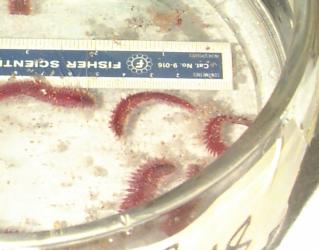 I went through the labs yesterday in an attempt to catch the scientists at work
on the latest treasures brought up by ROPOS. I have seen in my teaching that it
is often the biology of the sea that first attracts young students to the ocean.
The idea of becoming a marine biologist enters into the heads of many young
people well before they find out just how much work that career is going to
demand. However, in walking through the labs on the ship, I see that same kind
of enthusiasm displayed by the folks who have paid their dues and become working
marine biologists. They are genuinely and openly excited about what they are
doing. They want to share their new discoveries. That's not to say that other
disciplines aren't enthusiastic, but they tend to show their enthusiasm in a
different way. Actually it's no wonder, in this environment, that the
biologists become excited. Yesterday alone they found at least one, and
probably two new species of scale worms. Of course a thorough search of the
literature will be required before the claim of a new species will be
substantiated, but in an environment that has been little studied, most of what
appear to be new species turn out to be just that. One of the new scale worms
is considerably larger than any we have seen earlier in the voyage. These worms
were between 4 and 5 centimeters in length. (see photo above right)
I went through the labs yesterday in an attempt to catch the scientists at work
on the latest treasures brought up by ROPOS. I have seen in my teaching that it
is often the biology of the sea that first attracts young students to the ocean.
The idea of becoming a marine biologist enters into the heads of many young
people well before they find out just how much work that career is going to
demand. However, in walking through the labs on the ship, I see that same kind
of enthusiasm displayed by the folks who have paid their dues and become working
marine biologists. They are genuinely and openly excited about what they are
doing. They want to share their new discoveries. That's not to say that other
disciplines aren't enthusiastic, but they tend to show their enthusiasm in a
different way. Actually it's no wonder, in this environment, that the
biologists become excited. Yesterday alone they found at least one, and
probably two new species of scale worms. Of course a thorough search of the
literature will be required before the claim of a new species will be
substantiated, but in an environment that has been little studied, most of what
appear to be new species turn out to be just that. One of the new scale worms
is considerably larger than any we have seen earlier in the voyage. These worms
were between 4 and 5 centimeters in length. (see photo above right)

The microbiologists continue to inject sample of vent waters into air tight test tubes filled with different growth media. (photo left) The tubes are left for several hours to several days to see what kind of organisms will grow. When the tube turns cloudy it is a sure sign of rapid bacterial growth. In a cloudy liquid there may be upwards of 10,000.000 bacteria in each milliliter of solution,
Biology may be exciting, but in our hearts we know that Rocks Rule! Over at the
geology workstation,
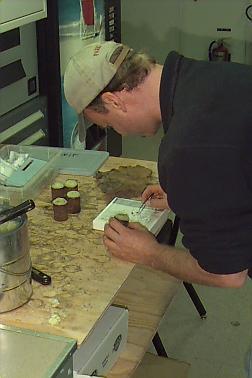 John Chadwick uses tweezers to pick pieces of crushed ocean
floor from the wax plugs that are a part of our rock coring system. The huge
chunk of ocean floor that was caught in the wire was unusual to say the least.
Most of what we will know of the geochemistry of these young basalt lavas will
come from pieces not much bigger than a sand grain. (photo right)
John Chadwick uses tweezers to pick pieces of crushed ocean
floor from the wax plugs that are a part of our rock coring system. The huge
chunk of ocean floor that was caught in the wire was unusual to say the least.
Most of what we will know of the geochemistry of these young basalt lavas will
come from pieces not much bigger than a sand grain. (photo right)
Testing of vent fluids continues in the chemistry area. Samples are sealed in
plastic or mylar bags and transferred using a large syringe. This is to keep
samples from exchanging gases with the atmosphere. Either absorbing a gas like
oxygen from the atmosphere or giving up a gas like methane to the atmosphere
would contaminate the sample.
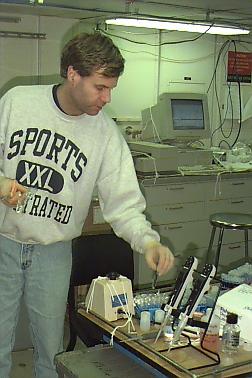 Given the many tests that
must be performed on each sample, only small quantities of seawater are allotted
to each test. Hundreds of test tubes and small bottles are carefully filled,
labeled, treated if necessary, and stored for later analysis. (photo left)
Given the many tests that
must be performed on each sample, only small quantities of seawater are allotted
to each test. Hundreds of test tubes and small bottles are carefully filled,
labeled, treated if necessary, and stored for later analysis. (photo left)
As this final week of our voyage winds down we are going to be asking the scientists to try to summarize what we have accomplished. It is the nature of science that one not jump to conclusions. It is better to let things settle out a bit before trying to see the big picture, so we won't be looking for any Earth-shaking announcements. NeMO, the New Millennium Observatory, is just that. It is an observatory. Scientists will come here many times to look again at the same place. Time will change what is observed. Eventually they will come to understand the place.
Logbook of all Teacher At Sea postings
Question/Answer of the Day
Send Your Question to NeMO
(oar.pmel.vents.webmaster@noaa.gov)
Back to Calendar